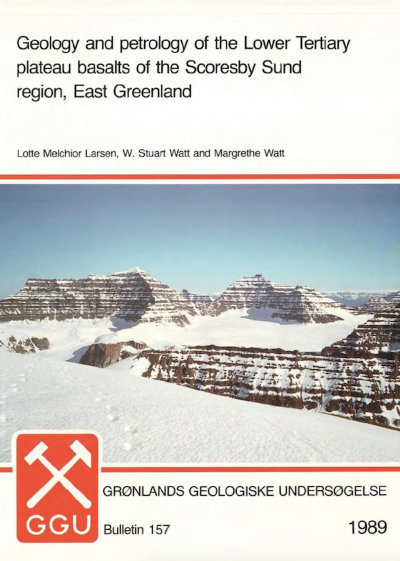Geology and petrology of the Lower Tertiary plateau basalts of the Scoresby Sund region, East Greenland
DOI:
https://doi.org/10.34194/bullggu.v157.6699Abstract
The early Tertiary plateau basalts in East Greenland are situated on a continental margin and were erupted during continental break-up and initiation of sea-floor spreading in the North Atlantic. In the region stretching from Scoresby Sund southward to 69°N 40 000 km2of basalts with an average thickness of 1.5 km have been investigated by measuring and flow-to-flow sampling of 130 profiles, followed by major element geochemical analysis and microprobe analysis, trace element analysis and some Sr isotope data. The basalts rest on Mesozoic sediments in the east and on Precambrian gneiss in the west. Six basalt formations are defined: the Magga Dan, Milne Land and Geikie Plateau Formations form a lower regional sequence erupted in one volcanic episode from sites in the NW part of the region; the Rømer Fjord and Skrænterne Formations form an upper regional sequence erupted in a subsequent volcanic episode in which eruption sites moved SE to centres east of the present Atlantic coast; the Igtertivâ Formation and a coast-parallel dyke swarm formed in a third volcanic episode only recorded at the Atlantic coast. The lavas are essentially flat-lying; a narrow strip along the Atlantic coast is extensively block faulted. Single lava flows are extensive (max. 11 000 km2) and voluminous (max. 300 km3). They are well preserved, with metamorphism of the low zeolite facies. All the lavas and most of the dykes are fractionated tholeiitic basalts with Mg/(Mg+Fe2+) ratios of 0.66-0.39 and TiO2 = 1.2-4.5%. The major part (the 'main basalts', 96% by volume) have Mg ratios of 0.56-0.39, while only 4 vol.% are Mg-rich basalts with Mg ratios of 0.66-0.57. A nephelinitic tuff layer occurs at the base of the second sequence. A few dykes are alkaline. The Mg-rich basalts have microphenocrysts of olivine (FO90-70) and chromite, while the main basalts comprise both aphyric and porphyritic sequences. Phenocrysts of plagioclase (An88-37) are abundant, of olivine (FO80-57) are sparse but ubiquitous, and of augite (FS9-20) sparse and often absent. Groundmass phases are olivine (to FO3737), plagioclase (to An13, augite (to FS62), pigeonite (Fs26-50), titanomagnetite and ilmenite. All rocks contain several per cent fine-grained mesostasis. The phenocrysts frequently show disequilibrium textures and a wide range of compositions within one sample. Extrusion temperatures are calculated to 1280-1110°C, and densities to 2.68-2.78 g/cm3, increasing with fractionation. The volcanic episodes are demonstrated in systematic compositional variations with height in the basalt sequence. Each of the two major episodes started with a variety of lava compositions including Mg-rich basalts, followed by a thick sequence of 'main basalts' showing a systematic decrease of TiO2 and other incompatible elements with height, and ending with a reversal to higher TiO2 values. The third episode is not cyclic, and its products have changed incompatible element ratios. The Mg-rich basalts comprise depleted MORB type basalts, relatively enriched olivine tholeiites, and very enriched tholeiites (Mikis type basalt). Sr isotopes show 87Sr/86Sr ratios of 0.7034 in most basalts and 0.7045 in the Mikis type basalt, while some Si-rich basalts have ratios up to 0.7079. The East Greenland basalts are 'initial rifting' basalts very similar to those in Deccan. The magmas have equilibrated at low pressures in crustal magma chambers. The main basalts have fractionated ol + pl + cpx no matter whether they are aphyric or porphyritic. Simple crystal fractionation can account for sub-trends but not for the complete compositional variation of the main basalts. This is considered as resulting from fractionation in open magma chambers which were repeatedly filled, mixed and tapped. The decrease in TiO2 with height in each volcanic episode indicates increasing magma input rate and shorter residence time in the chamber, while the final reversal indicates the decline and cessation of activity. There is evidence for widespread crustal contamination (1-4%) in the magma chambers of the two lowest formations. Crustal contamination of magmas on the way to the surface occurred sporadically throughout both sequences. One case of magma mixing occurred when a Mg-rich basalt magma invaded the regional main basalt magma chamber. The Mg-rich basalts cannot be directly related to each other or to the main basalts. A petrogenetic scheme is suggested where the Mikis type basalt originated in, or contains an addition from, an undepleted or enriched mantle source. All the other magma types originated in a depleted mantle source by varying degrees and possibly depths of melting. Increasing degrees of melting are indicated for the types nephelinite - enriched olivine tholeiite – main basalt parent – MORB type basalt. The MORB type basalt may also be produced by melting of a residuum. The basalts of the third volcanic episode include another component of mantle or basaltic crust. The three recorded volcanic episodes are related to rifting events during the break-up of the North Atlantic continent, viewed as repeated attempts to straighten out a bend in the original line of opening. The two first rifting events failed while the third for a short while produced oceanic crust. Compared to other regions of the North Atlantic volcanic province the Scoresby Sund basalts are similar to basalts from Kangerdlugssuaq, northern East Greenland, West Greenland, the Faeroes, the Vøring Plateau and some basalts on lceland. The main magma source for the North Atlantic province was similar to that of the lceland hotspot, but enriched subcontinental lithosphere may also have participated in the stage of initial rifting. A correlation for the volcanic episodes throughout East Greenland and the Faeroes is proposed.
Downloads
Published
Issue
Section
License
Copyright (c) 1989 L.M Larsen, W.S Watt, M Watt

This work is licensed under a Creative Commons Attribution 4.0 International License.
This article is distributed under a CC-BY 4.0 licence, permitting free redistribution and reproduction for any purpose, even commercial, provided proper citation of the original work. Author(s) retain copyright over the article contents.


